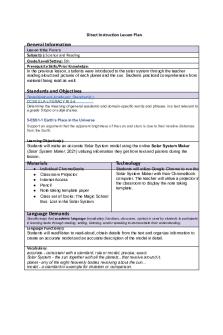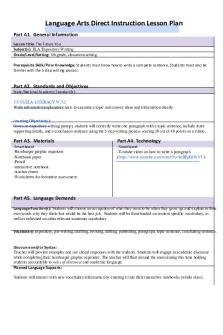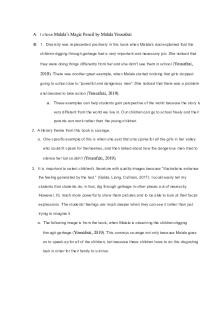Lesson Plan task 1 PDF

| Title | Lesson Plan task 1 |
|---|---|
| Author | McKenzie Nicole |
| Course | Instructional Planning and Presentation in Elementary and Special Education |
| Institution | Western Governors University |
| Pages | 6 |
| File Size | 229.6 KB |
| File Type | |
| Total Downloads | 62 |
| Total Views | 178 |
Summary
Task 1 lesson plan, passed first try...
Description
Direct Instruction Lesson Plan Template McKenzie Story
General Information Lesson Title: Matter Subject(s): Science Grade/Level/Setting: This lesson will take place in a regular 3rd grade education classroom. There are a 28 students total (16 boys and 12 girls) with19 students are ongrade-level readers, 5 students are two grades above reading level (2 are identified as gifted and talented), 2 students are English learners at the intermediate level, and!2 students who are identified as having special needs. Students will be put into groups of four. The classroom is set where the students desk are placed into a rectangle with their 4 desks. There is a rectangular table that seats 6 in the back of the classroom for one to one teaching and small group. The teachers desk is in the front corner of the classroom. There is a large interactive whiteboard at the front of the classroom. Expectations/ classroom rules are posted above the whiteboard. There is an Elmo (projector) for use if needed. Table 1: 3 on grade level, 1 student two grades above reading level Table 2: 2 students two grades above reading level, 2 students on grade level Table 3: 1 student identified as having special needs, 3 students on grade level Table 4: 1 student identified as having special needs, 1 student English learner on intermediate level, 2 on grade level Table 5: 1 student English learner on intermediate level, 1 student identified as gifted, 2 at grade level Table 6: 3 students at grade level, 1 student identified as gifted Table 7: 4 students at grade level Prerequisite Skills/Prior Knowledge: The students have prior knowledge that all things are made up of matter. Students know the definition of matter as anything that has mass and takes up space.
Standards and Objectives State/National Academic Standard(s):
3.PS1: Matter and Its Interactions: 1) Describe the properties of solids, liquids, and gases and identify that matter is made up of particles too small to be seen. Learning Objective(s):
1. Students will be able to classify different kinds of matter and complete the activity sheet by correctly identifying items as solid, liquid, or gas with 100% accuracy.
Materials
Technology
Various items: solids, liquids, gases ex. blocks, water, ice cubes, soda, helium tank (blow up a balloon) A worksheet with the items to identify will be provided.
Use a simulator/game to show solids, liquids, gases Watch videos that show items as solids, liquids, and gases Will use Elmo to show How will you use technology to enhance teaching and learning? (Optional: Use the SAMR model to explain the technology integration strategies you plan to use.)
Language Demands Specific ways that academic language (vocabulary, functions, discourse, syntax) is used by students to participate in learning tasks through reading, writing, listening, and/or speaking to demonstrate their understanding.
Language Function(s): Students will identify objects as being a solid, liquid, and gas as it relates to matter. The content and language focus of the learning task represented by the active verbs within the learning outcomes. Common language functions include identifying main ideas and details; analyzing and interpreting characters or events; arguing a position or point of view; or predicting, recording, and evaluating data. Common language functions in math include predicting from models and data, recording multiple ways to solve problems, justifying conclusions, evaluating data and explaining how or why certain strategies work.
Vocabulary: Solid Liquid Gas Matter Includes words and phrases that are used within disciplines including: (1) words and phrases with subject-specific meanings that differ from meanings used in everyday life (e.g., table); (2) general academic vocabulary used across disciplines (e.g., compare, analyze, evaluate); and (3) subject-specific words defined for use in the discipline.
!
Discourse and/or Syntax: Student groups will identify solids, liquids, and gases by placing marks on a form given to them to represent what they see with each item. Discourse includes the structures of written and oral language, as well as how members of the discipline talk, write, and participate in knowledge construction. Syntax refers to the set of conventions for organizing symbols, words, and phrases together into structures (e.g., sentences, graphs, tables).
Planned Language Supports: Posters around room to help guide with understanding of Solids, liquids, and gases Bolded words to show meaning and importance. The scaffolds, representations, and pedagogical strategies teachers intentionally provide to help learners understand and use the concepts of language they need to learn within disciplines.
Instructional Strategies and Learning Tasks
Anticipatory Set: Activity Description/Teacher Student Actions -Students will provide thoughts inside their journals to discuss with their groups. Then ideas will be shared with the class. List key questions inside science journal. - What is a solid? -What is a liquid? -What is a gas? -Why are particles different in solids, liquids, and gases? -Share what you notice and wonder
Presentation Procedures for New Information and/or Modeling: Activity Description/Teacher Student Actions -Teacher will show solids, liquids, and gases on her Elmo projector, Teacher will give 1 example of each so that the students understand what they are identifying. - students watch and discuss with their shoulder partner as practice, to identify various types of matter. - Students will work in groups of four and discuss what they find. - Students will write down their answers on the worksheet provided.
Guided Practice: Activity Description/Teacher Student Actions -Teacher will introduce topic of matter. -Teacher will place students into their assigned groups. There will be 7 different groups of 4. -Using their prior knowledge and what they have learned throughout the lesson. Students will identify states of matter. -Throughout the lesson, students will work in their groups, they will discuss amongst their groups what property of matter is listed on their worksheet. I will be available for questions if students may have some. I will be walking around the classroom -When the students are finished with their lesson, the teacher will bring all the students back together to whole group discuss the correct answers. -On a separate sheet of paper that the teacher will provide after the lesson is complete students will circle on a scale of 1-3 how difficult it was to identify each state of matter. (1 being easy-3 being hard)
Independent Student Practice: Activity Description/Teacher Student Actions -After teacher instruction, students will work in their groups of 4 using the worksheet and items provided to identify the states of matter. -After using a rating scale, students will independently write a 3-5 sentence paragraph explaining one of the properties of matter. This should include at least 2 properties: shape, color, smell, is it a physical object?, etc.
Culminating or Closing Procedure/Activity: Activity Description/Teacher Student Actions -Students will share their observations they found on their worksheet. - Volunteers will read what they got when the teacher calls on them. - Teacher will collect their paragraph they have written and grade them.
Differentiated Instruction Consider how to accommodate for the needs of each type of student. Be sure that you provide content specific accommodations that help to meet a variety of learning needs.
Gifted and Talented: Have students determine if the state of matter they are identifying can evaporate or condensate if it can melt or freeze. Explain in their paragraph what EVAPORATION and CONDENSATION are and how they are properties of matter. EL: Provide the students with the vocabulary they will be using throughout the lesson the day before and make sure to have them paired with English speaking peers. Students with Other Special Needs: Explain to students in multi-step directions. Print off directions to place on their desk for these students to be able to refer to throughout the lesson. Allow student to use their computer to answer the questions. Modify worksheet as needed. Provide any additional information to help guide students.
Assessment Formative Guided questioning throughout the lesson to check for student understanding as stated above. Describe how you will monitor, support, and extend student thinking.
Summative
Complete the activity sheet by correctly identifying items as solid, liquid, or gas with 100% accuracy. (Quizzes, Tests, products)
Active participation: I used a hands-on activity to incorporate active participation throughout the class. During the guided insertion portion I asked the students to complete a worksheet on matter by using various items to identify. During this guided practice, the students were in groups and could refer to their partners to assist them in identifying the items. The students were also asked at the end of the lesson to complete a rubric on their thoughts about the hardness of identifying the items was. The students were also asked to complete a 3-5 sentence paragraph to show understanding of what they just completed. (Pearson,2011) Grouping Strategy: I placed students into 7 different groups of 4 persons in each. These groups had various learners in each group.This would allow each student to work together and express themselves in their own way. Students worked together to provide the correct information on the items they were identifying whether that be a solid, liquid, or gas. By providing the EL students the opportunity to work with other English speaking students this will give them the opportunity to ask question when they do not understand a word but all be able to communicate with them throughout the lesson. By letting the students work together, you are giving them the opportunity to communicate with each other and provide various ideas and provide helpful information to help their peers. (Pearson,2011)
Technology Strategy: During the lesson I will use the Elmo to show the worksheet that the student will be completing. I will also use various videos to provide throughout the classroom instruction time. Their will be different visuals provided throughout the classroom. By using the Elmo this will provide students to incorporate cooperative learning among the students because we are working together to go over the lesson and be able to understand it. (Huzinec, 2016) Assessment Strategy: I provided a formative assessment by giving the students a matter worksheet to complete after the guided and independent practice. The students will be graded on how many they got correct. This allows me as the teacher to check for understanding and review with them before taking a final summative assessment. During the guided practice this allowed students to work together and ask questions to their peers or teacher to make sure they are doing it correctly. (Pearson, 2011)
References: Huzinec, C. (2016, June 06). Using "Affective Teaching" Methods to Improve Students' Motivation: Pearson Blog. Retrieved January 13, 2021, from https://www.pearsoned.com/using-affectiveteaching-methods-to-improve-students-motivation-to-learn-and-their-performance/ Person. (2011, November 30). 10 Powerful Instructional Strategies. Retrieved January 13, 2021, from https://www.edutopia.org/stw-school-turnaround-student-engagement-video...
Similar Free PDFs

Task 1 - Lesson Plan
- 6 Pages

Task 1 - Lesson Plan
- 8 Pages

Lesson Plan task 1
- 6 Pages

BDM2 Task 1 lesson plan
- 15 Pages

Lesson Plan / task
- 7 Pages

Lesson Plan - - Task 2
- 7 Pages

Task 1 Math Tools lesson plan
- 13 Pages

C732 Task 1 Lesson Plan - Passed
- 6 Pages

HXM1 Task 1 pdf - lesson plan
- 5 Pages

Geometry Task 2 Lesson Plan
- 7 Pages

C365 Lesson Plan Task 1.docx
- 8 Pages

C970 Lesson - Task 1
- 15 Pages
Popular Institutions
- Tinajero National High School - Annex
- Politeknik Caltex Riau
- Yokohama City University
- SGT University
- University of Al-Qadisiyah
- Divine Word College of Vigan
- Techniek College Rotterdam
- Universidade de Santiago
- Universiti Teknologi MARA Cawangan Johor Kampus Pasir Gudang
- Poltekkes Kemenkes Yogyakarta
- Baguio City National High School
- Colegio san marcos
- preparatoria uno
- Centro de Bachillerato Tecnológico Industrial y de Servicios No. 107
- Dalian Maritime University
- Quang Trung Secondary School
- Colegio Tecnológico en Informática
- Corporación Regional de Educación Superior
- Grupo CEDVA
- Dar Al Uloom University
- Centro de Estudios Preuniversitarios de la Universidad Nacional de Ingeniería
- 上智大学
- Aakash International School, Nuna Majara
- San Felipe Neri Catholic School
- Kang Chiao International School - New Taipei City
- Misamis Occidental National High School
- Institución Educativa Escuela Normal Juan Ladrilleros
- Kolehiyo ng Pantukan
- Batanes State College
- Instituto Continental
- Sekolah Menengah Kejuruan Kesehatan Kaltara (Tarakan)
- Colegio de La Inmaculada Concepcion - Cebu



